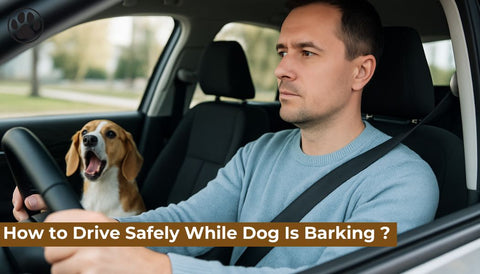
How Do Dogs Know to Get Someone to Help ?
of reading - words
Dogs have long been considered humanity's loyal companions, offering unconditional love, comfort, and even life-saving assistance in times of need. Stories of dogs alerting others when their owners are in danger or seeking help in emergencies are not uncommon. But how do dogs instinctively know when to get help, and what drives their actions in these critical moments? This article delves into the science, instincts, and training behind this remarkable canine behavior.
The Instinctive Nature of Dogs
At the heart of a dog’s ability to seek help lies its strong pack instincts. Dogs are social animals, and their ancestors, wolves, thrived by relying on their pack members for survival. This innate sense of responsibility to their group has been passed down to modern dogs, shaping behaviors that prioritize the well-being of their "pack"—a role now often filled by humans.
When dogs sense that something is wrong, they are driven by this instinct to take action. Whether it’s barking to alert others or physically seeking someone to assist, dogs often act out of a natural desire to protect and care for their pack members.
Canine Empathy: Recognizing Distress
One of the reasons dogs are so adept at knowing when their humans need help is their keen sense of empathy. Research shows that dogs can recognize human emotions through a combination of body language, vocal tones, and even subtle changes in scent. For example:
- Body Language: Dogs are highly perceptive and can detect when their owner is behaving unusually, such as collapsing or showing signs of distress.
- Tone of Voice: Dogs respond to changes in vocal pitch or urgency, allowing them to discern if something is wrong.
- Scent Changes: Dogs can smell chemical changes in the human body caused by stress, fear, or illness, giving them early warning signs of trouble.
These abilities enable dogs to respond proactively when they sense their owner or another person is in need of assistance.
Training and Learned Behaviors
While instinct plays a significant role, training enhances a dog’s ability to get help in emergencies. Service dogs, for instance, undergo specialized training to respond to specific situations, such as:
- Alerting medical personnel or family members when their owner has a seizure.
- Guiding a lost or disoriented person to safety.
- Fetching emergency items, like phones or medical kits.
Even non-service dogs can learn these behaviors through consistent positive reinforcement training. For example, teaching a dog to "find help" or "get someone" can involve:
- Establishing Commands: Using verbal cues like "go get help" or "find someone."
- Rewarding Behavior: Praising and rewarding the dog when they successfully perform the desired action.
- Simulating Scenarios: Practicing emergency situations so the dog becomes comfortable responding appropriately.
This training strengthens the natural tendencies dogs already possess and ensures they act reliably when it matters most.
The Role of Bond and Trust
A strong bond between a dog and its owner significantly influences the likelihood of a dog seeking help in an emergency. Dogs are more likely to act on behalf of someone they trust and view as part of their pack. This connection fosters loyalty and enhances their willingness to take risks, such as leaving their owner’s side to find assistance.
Studies have shown that dogs with secure, positive relationships with their owners are quicker to respond to distress signals. This underscores the importance of building trust and communication with your dog through consistent care, attention, and training.
Famous Examples of Dogs Getting Help
Countless real-life stories highlight dogs’ ability to save lives by getting help. Here are just a few remarkable examples:
- The Loyal Collie: A collie named Lassie famously alerted neighbors when her owner had fallen into a ravine. Her persistence and intelligence were credited with saving his life.
- A Seizure-Alert Dog: A Labrador in the UK was trained to detect seizures in his owner and fetched help when she collapsed. His actions prevented further harm.
- Stray Hero: In Turkey, a stray dog barked and guided paramedics to an injured man lying unconscious in a park, demonstrating that even untrained dogs can exhibit heroic behavior.
These stories remind us of the extraordinary bond between dogs and humans and their willingness to go above and beyond for their loved ones.
How Dogs Communicate for Help
When dogs seek help, they use various forms of communication to get their message across. These include:
- Barking: Dogs bark loudly and persistently to grab attention and signal that something is wrong.
- Leading Someone: Many dogs will tug at clothing or nudge someone to follow them to the source of the problem.
- Physical Gestures: Dogs may paw, jump, or use body language to convey urgency.
These actions are not random but are deliberate attempts to communicate and solve a problem, showcasing their intelligence and adaptability.
The Science Behind Dogs’ Heroic Behavior
Several studies have explored why dogs are so inclined to help in emergencies:
- Problem-Solving Skills: Dogs are intelligent animals capable of identifying problems and taking steps to resolve them.
- Social Intelligence: Dogs have evolved alongside humans for thousands of years, developing an unparalleled understanding of human behavior.
- Oxytocin Levels: Known as the "love hormone," oxytocin fosters bonds between dogs and humans. Higher oxytocin levels may drive dogs to act altruistically toward their owners.
This combination of cognitive, emotional, and hormonal factors creates the perfect conditions for dogs to act as protectors and helpers.
Can Any Dog Learn to Get Help?
While certain breeds, such as Border Collies, German Shepherds, and Golden Retrievers, are naturally inclined to help due to their intelligence and trainability, any dog can be taught to seek help in emergencies. The key lies in:
- Early socialization to build confidence and adaptability.
- Consistent training to reinforce helpful behaviors.
- A strong, trusting relationship with the owner.
Every dog is unique, and with the right guidance, even the most unlikely candidates can become heroes.
Frequently Asked Questions
1. How do dogs sense danger?
Dogs have heightened senses of smell, hearing, and sight, allowing them to detect changes in their environment. They also pick up on emotional cues, body language, and chemical changes in humans, which can alert them to danger.
2. Can all dogs be trained to get help?
Yes, most dogs can be trained to seek help in emergencies. However, some breeds may learn more quickly due to their intelligence and work ethic. Patience and consistency are key.
3. Are service dogs better at getting help?
Service dogs receive specialized training to handle specific tasks and emergencies, making them more reliable in critical situations. However, non-service dogs can still perform heroic acts, especially when motivated by a strong bond with their owner.
4. What should I do to teach my dog to get help?
Start by using verbal commands like "find help" and reward your dog for performing the desired behavior. Simulate emergency scenarios and practice regularly to reinforce the training.
5. Why do stray dogs sometimes help humans?
Stray dogs may act on instinct and empathy, which are natural to their species. Even without training, dogs have an innate drive to protect and assist those they view as part of their social group.
Conclusion
Dogs’ ability to know when and how to get help is a testament to their intelligence, loyalty, and deep connection with humans. Whether it’s through instinct, training, or sheer empathy, these remarkable animals continue to save lives and provide unparalleled support to their owners. Building trust and reinforcing helpful behaviors can empower your dog to be a reliable companion in times of need. By understanding and nurturing this unique bond, you ensure that your furry friend remains a loyal and capable member of your family.




